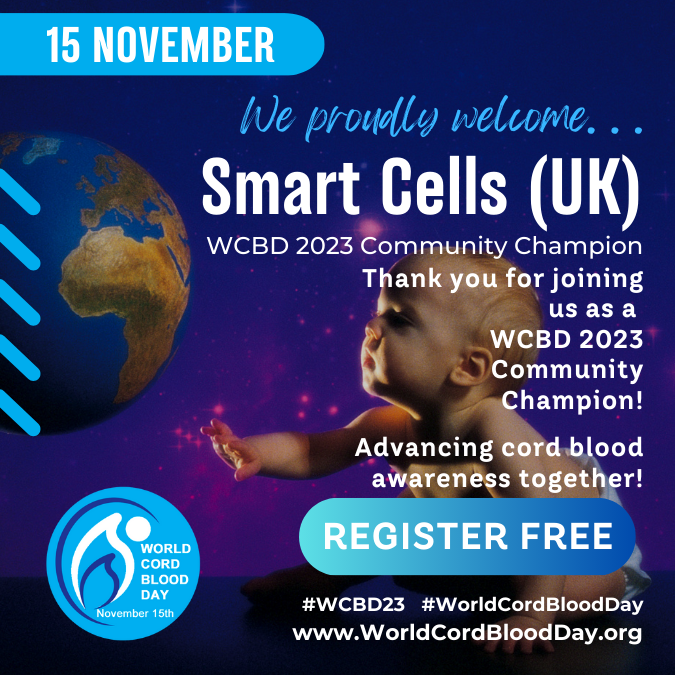

World Cord Blood Day is an important occasion that aims to raise awareness about the invaluable natural resource that is cord blood and its potential in medical treatments.
This year, we want to shed light on a concerning statistic – in the United States, 3% of births bank their cord blood, while in the UK, only 0.3% of births take advantage of this life-saving opportunity.
Why is World Cord Blood Day so important?
In the absence of up-to-date knowledge about cord blood, we risk missing out on a valuable opportunity, causing both doctors and parents to unknowingly discard this precious resource. World Cord Blood Day gives us the opportunity to create those conversations that might just save a life, even just one conversation could make a difference!
Saving cord blood does not just give families hope, it gives them power.
While there is still room for improvement in terms of awareness around the uses of cord blood stem cells and how families can store them, there is plenty of good news too!
In the past 20 years, the number of cord blood transplants performed worldwide has increased by over 20-fold!
Cord blood transplants are not just for children; they can be used to treat patients of all ages, from newborns to adults, and even other family members too. They are also more successful than bone marrow transplants, especially when used for children.
The Benefits of Cord Blood Banking
It’s essential to understand the significant advantages of preserving cord blood stem cells so that the right knowledge can be shared. Cord blood is a rich source of hematopoietic stem cells, which can be used to treat a wide range of more than 80 different diseases, including leukaemia, lymphoma, and other blood-related disorders. Additionally, cord blood stem cells have shown promise in regenerative medicine and the treatment of neurological conditions, such as cerebral palsy and autism.
Why is cord blood so valuable?
Cord blood is an incredibly valuable resource for several reasons:
- Packed with Stem Cells: Cord blood is rich in hematopoietic stem cells, which can transform into various cell types, making them ideal for a wide range of medical treatments.
- Immunological Immaturity: Cord blood stem cells have an immunological immaturity that can be advantageous for transplant compatibility, reducing the risk of graft-versus-host disease.
- Reduced Risk of Transmission: Cord blood carries a lower risk of transmitting infections compared to other sources of stem cells.
What is cord blood used for?
Cord blood can be used for a variety of medical treatments, including:
- Treating Blood Disorders: Cord blood stem cells are particularly effective in treating blood-related disorders, such as leukaemia, lymphoma, and anaemia.
- Regenerative Medicine: Cord blood has shown promise in the treatment of neurological conditions, including cerebral palsy, autism, and brain injuries.
- Advancements in Cancer Treatment: Cord blood stem cells play a crucial role in improving the effectiveness of cancer treatments and reducing complications.
Should I save my baby’s cord blood?
The decision to save your baby’s cord blood is a personal one, but it is a choice that can potentially benefit your child and others in the future. By banking cord blood, you provide an insurance policy for your family. If a medical condition arises, having access to your baby’s cord blood stem cells can be a life-saving option. Moreover, your decision could contribute to scientific research and the development of medical breakthroughs, benefiting countless individuals.
Where can I bank my baby’s cord blood?
Here at Smart Cells, we are based in the UK but have branches in Dubai and Hong Kong. We are also part of the FamiCord group who are the biggest cord blood bank in Europe and have cord blood banks and labs around the world. There are family banks all over the world, this map may be useful in helping you find the one that is best for you.
As we’ve mentioned, in the UK only 0.3% of parents bank their baby’s cord blood compared to 3% in the US, a huge disparity. In the US, cord blood has been stored at nearly 4 million births! These figures differ hugely around the world too, for example, Hong Kong has a rate of 3.5% of births having cord blood stored, and up to a huge 10% in Greece! You can find out more of these stats here.
By increasing awareness, making banking more affordable, and addressing regulatory concerns, the UK can catch up with the US in harnessing the full potential of cord blood stem cells. Cord blood banking is a gift of life, offering incredible promise in cancer treatment and regenerative medicine. The decision to save your baby’s cord blood is one that holds the potential to change lives and drive innovation in healthcare. Let’s seize this chance together and bridge the gap to unlock cord blood’s vast potential for the betterment of healthcare and future medical breakthroughs.
How can I find more information on cord blood banking?
The FamiCord group is also organising and participating in a range of events to celebrate World Cord Blood Day. On 15th November at 11:00 AM CET, there will be a panel discussion in Berlin about the importance of cord blood banking, the status of samples released, diseases treated, and ongoing clinical trials with Prof. Krzysztof Kałwak, President of the EBMT Pediatric Diseases Working Group, Matthew Farrow, the first patient to receive a cord blood transplant, and Prof. Michael Abou-Dakn, Director of St. Joseph’s Gynecological & Perinatal Clinic in Berlin.
There are also conferences being held by the FamiCord Group with Matthew Farrow in attendance:
- November 14, 2023, in Warsaw
- November 16, 2023, in Bucharest
- November 17, 2023, in Rome
We have a free guide here that can help you to understand what cord blood banking is all about and aims to answer all your questions. Our top 10 most frequently asked questions about cord blood may also be useful too.



